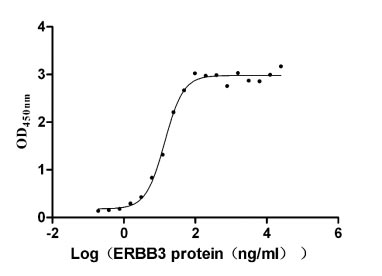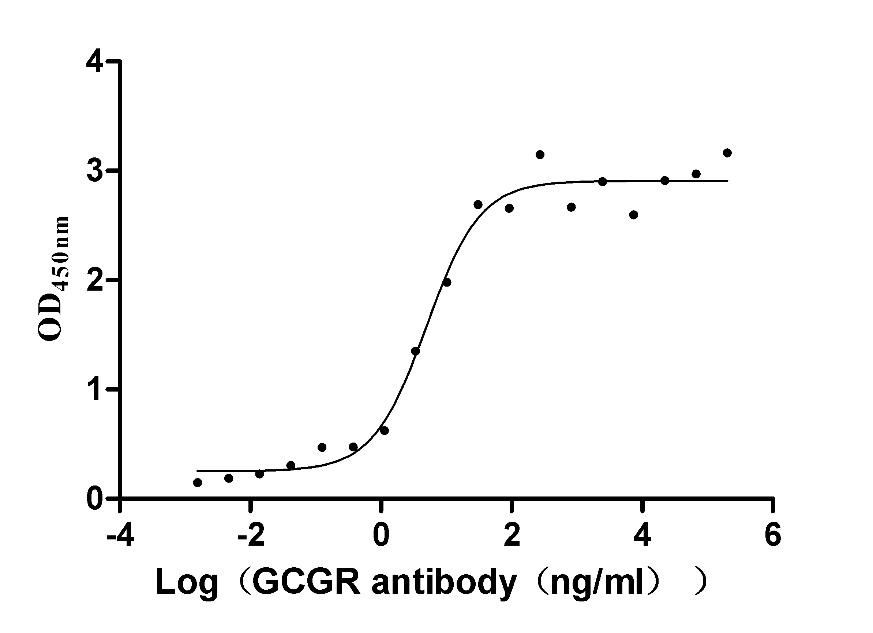Recombinant Mouse Lactoylglutathione lyase (Glo1)
-
中文名称:小鼠Glo1重组蛋白
-
货号:CSB-YP871864MO
-
规格:
-
来源:Yeast
-
其他:
-
中文名称:小鼠Glo1重组蛋白
-
货号:CSB-EP871864MO
-
规格:
-
来源:E.coli
-
其他:
-
中文名称:小鼠Glo1重组蛋白
-
货号:CSB-EP871864MO-B
-
规格:
-
来源:E.coli
-
共轭:Avi-tag Biotinylated
E. coli biotin ligase (BirA) is highly specific in covalently attaching biotin to the 15 amino acid AviTag peptide. This recombinant protein was biotinylated in vivo by AviTag-BirA technology, which method is BriA catalyzes amide linkage between the biotin and the specific lysine of the AviTag.
-
其他:
-
中文名称:小鼠Glo1重组蛋白
-
货号:CSB-BP871864MO
-
规格:
-
来源:Baculovirus
-
其他:
-
中文名称:小鼠Glo1重组蛋白
-
货号:CSB-MP871864MO
-
规格:
-
来源:Mammalian cell
-
其他:
产品详情
-
纯度:>85% (SDS-PAGE)
-
基因名:Glo1
-
Uniprot No.:
-
别名:Glo1Lactoylglutathione lyase; EC 4.4.1.5; Aldoketomutase; Glyoxalase I; Glx I; Ketone-aldehyde mutase; Methylglyoxalase; S-D-lactoylglutathione methylglyoxal lyase
-
种属:Mus musculus (Mouse)
-
蛋白长度:Full Length of Mature Protein
-
表达区域:2-184
-
氨基酸序列AEPQPASSG LTDETAFSCC SDPDPSTKDF LLQQTMLRIK DPKKSLDFYT RVLGLTLLQK LDFPAMKFSL YFLAYEDKND IPKDKSEKTA WTFSRKATLE LTHNWGTEDD ETQSYHNGNS DPRGFGHIGI AVPDVYSACK RFEELGVKFV KKPDDGKMKG LAFIQDPDGY WIEILNPNKI ATII
-
蛋白标签:Tag type will be determined during the manufacturing process.
The tag type will be determined during production process. If you have specified tag type, please tell us and we will develop the specified tag preferentially. -
产品提供形式:Lyophilized powder
Note: We will preferentially ship the format that we have in stock, however, if you have any special requirement for the format, please remark your requirement when placing the order, we will prepare according to your demand. -
复溶:We recommend that this vial be briefly centrifuged prior to opening to bring the contents to the bottom. Please reconstitute protein in deionized sterile water to a concentration of 0.1-1.0 mg/mL.We recommend to add 5-50% of glycerol (final concentration) and aliquot for long-term storage at -20℃/-80℃. Our default final concentration of glycerol is 50%. Customers could use it as reference.
-
储存条件:Store at -20°C/-80°C upon receipt, aliquoting is necessary for mutiple use. Avoid repeated freeze-thaw cycles.
-
保质期:The shelf life is related to many factors, storage state, buffer ingredients, storage temperature and the stability of the protein itself.
Generally, the shelf life of liquid form is 6 months at -20°C/-80°C. The shelf life of lyophilized form is 12 months at -20°C/-80°C. -
货期:Delivery time may differ from different purchasing way or location, please kindly consult your local distributors for specific delivery time.Note: All of our proteins are default shipped with normal blue ice packs, if you request to ship with dry ice, please communicate with us in advance and extra fees will be charged.
-
注意事项:Repeated freezing and thawing is not recommended. Store working aliquots at 4°C for up to one week.
-
Datasheet :Please contact us to get it.
靶点详情
-
功能:Catalyzes the conversion of hemimercaptal, formed from methylglyoxal and glutathione, to S-lactoylglutathione. Involved in the regulation of TNF-induced transcriptional activity of NF-kappa-B. Required for normal osteoclastogenesis.
-
基因功能参考文献:
- Transgenic mice overexpressing Glo1 on both FVB/NJ (FVB) or C57BL/6J (B6) backgrounds showed increased voluntary EtOH consumption compared to their wild-type littermates. Transgenic Glo1 knockdown mice on a B6 background showed decreased voluntary EtOH consumption. Genetic manipulations of Glo1 had no effect on sucrose, saccharin or water consumption. PMID: 26691867
- the Glo1-methylglyoxal pathway integrates maternal and neural precursor cell metabolism to regulate neural development. PMID: 27760310
- These data indicate that Glo1 knockout reduces anxiety-like behavior, but increases depression-like behavior. PMID: 28623132
- Alternative detoxification of methylglyoxal in GLO1(-/-) is achieved by increased catalytic efficiency of aldose reductase toward hemithioacetal (product of glutathione and methylglyoxal ), which is most likely caused by S-nitrosylation of aldose reductase. PMID: 27956549
- Glo1 knockdown does not have major short term effects on the energy expenditure or the formation of atherosclerotic plaques. PMID: 26788517
- Crystal structure of the mouse Glo1-inhibitor complex was determined at 2.3 A resolution. PMID: 26279158
- Study demonstrates that GLO1 is a novel metabolic oncogene of the 6p21 amplicon, which promotes tumor growth and aberrant transcriptional signals via regulating cellular metabolic activities for energy production. PMID: 24662817
- Glyoxalase expression prevents against ischemic neuronal cell damage and ameliorates ischemic injury. PMID: 24252591
- the balance between methylglyoxal and age-dependent GLO1 downregulation contributes to delayed wound healing in old mice PMID: 23797271
- The difference in glyoxalase-1 mRNA was observed with Fkbp5-/- mice expressing 2-fold more glyoxylase-1 protein. PMID: 23733890
- pharmacological inhibition of GLO1 reduced anxiety, suggesting that GLO1 is a possible target for the treatment of anxiety disorders. PMID: 22585572
- These results suggest that GLO-1 plays a role in high glucose-mediated signaling by reducing mesangial cells accumulation and oxidative stress in diabetes mellitus. PMID: 22036650
- Findings reveal that the abundance of GLO1 varies between different murine strains and within different sensory neuron populations. PMID: 21633909
- Data show that reducing RGS2 expression by antisense treatment prevented the increase in GLO1 and GSR1 mRNA and protein expression. PMID: 21510939
- Data demonstrate GLO1 expression and glycation damage to be induced by alpha-synuclein ablation leading to the suggestion that wild-type alpha-synuclein modulates brain glucose metabolism. PMID: 20711648
- Glo-I is a novel molecular target for treatment of Bcr-Abl(+) leukemias, and Abl TKI-resistant quiescent Bcr-Abl(+) leukemic cells that have acquired stem-like characteristics in the process of adapting to a hypoxic environment. PMID: 20139893
- Tumor necrosis factor-induced modulation of glyoxalase I activities through phosphorylation by PKA results in cell death and is accompanied by the formation of a specific methylglyoxal-derived AGE. PMID: 11792832
- Local overexpression in the mouse brain resulted in increased anxiety-like behaviour; Glo1 is involved in oxidative stress metabolism, linking this pathway with anxiety-related behaviour PMID: 16244648
- In diabetes there is an upregulation of glyoxalase I, but this upregulation is inadequate to normalize MGO levels, which could lead to MGO retention and chemical modification of proteins. PMID: 16583141
- Glo1 expression was upregulated in liver and hypothalamus of congenic mice when compared with B6 mice PMID: 16946080
- Expression of 40 proteins, including the antioxidative enzymes peroxiredoxin 1 and 3, glutathione peroxidase 1, and SOD-1, was increased with diabetes, suggesting an adaptive response to oxidative stress associated with this diabetic model. PMID: 17609286
- methyl-gerfelin targets GLO1, resulting in the inhibition of osteoclastogenesis PMID: 18695250
- findings provide a molecular basis for differential expression of Glo1 and further implicate Glo1 in anxiety-like behavior PMID: 19266052
显示更多
收起更多
-
蛋白家族:Glyoxalase I family
-
数据库链接:
KEGG: mmu:109801
STRING: 10090.ENSMUSP00000024823
UniGene: Mm.261984
Most popular with customers
-
Recombinant Human Receptor tyrosine-protein kinase erbB-3 (ERBB3), partial (Active)
Express system: Mammalian cell
Species: Homo sapiens (Human)
-
Recombinant Human Glucagon receptor (GCGR), partial (Active)
Express system: Mammalian cell
Species: Homo sapiens (Human)
-
Express system: Mammalian cell
Species: Homo sapiens (Human)
-
Recombinant Human C-type lectin domain family 4 member C (CLEC4C), partial (Active)
Express system: Mammalian cell
Species: Homo sapiens (Human)
-
Recombinant Human Interleukin-2 receptor subunit alpha (IL2RA), partial (Active)
Express system: Mammalian cell
Species: Homo sapiens (Human)
-
Recombinant Human CUB domain-containing protein 1 (CDCP1), partial (Active)
Express system: Mammalian cell
Species: Homo sapiens (Human)
-
Recombinant Human Myosin regulatory light chain 12B(MYL12B) (Active)
Express system: E.coli
Species: Homo sapiens (Human)
-
Recombinant Human Transmembrane 4 L6 family member 1(TM4SF1)-VLPs (Active)
Express system: Mammalian cell
Species: Homo sapiens (Human)




















